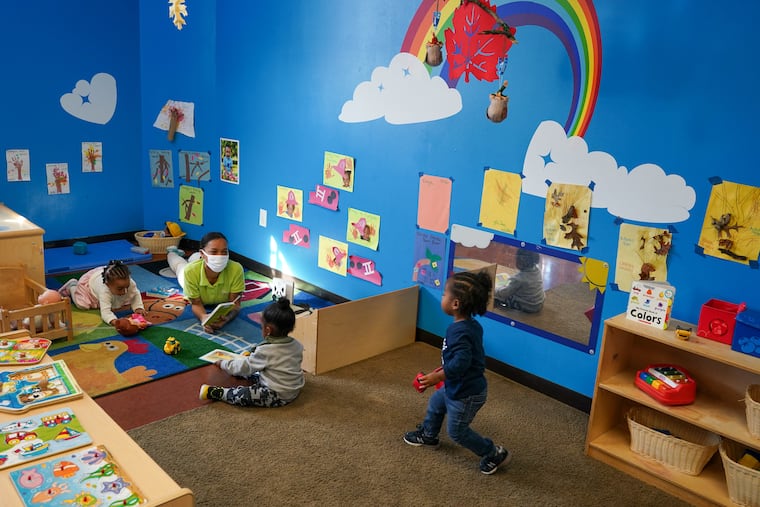‘A real crisis’: Five takeaways from a new survey on childcare worker pay in Pennsylvania
While parents are struggling to pay for daycare, childcare teachers are getting paid less than a living wage across the state, a new survey by Children First PA found.

Kashmeira Harris, executive director of A Secure Future Academy in West Philadelphia, said she would like to be able to pay her staff more — they’re currently making $13 per hour — but she can’t afford to do so without raising the cost for her customers, and she worries that would price some of them out of the center. In order to pay that wage, she only pays herself for about 25 hours a week, even though she works full time running the center.
While many parents are struggling to pay for childcare, many childcare providers, like Harris, are struggling to make ends meet themselves.
The average early childhood teacher in the Philadelphia region makes less than $30,000 per year, according to a new report by local advocacy organization Children First PA. The new statewide data, based on wage records of 30,000 childcare workers and a survey of 3,400 early childhood educators, comes as parents in Philadelphia and across the country are already putting untenably large chunks of their income into childcare payments, and staffing shortages have caused long waitlists at many centers.
“It’s a real crisis right now,” said Mai Miksic, early childhood education policy director at Children First, who wrote the report. “The only solution here is for government to step in and subsidize the sector in a way it does for agriculture and energy and other sectors that society relies on.”
Pennsylvania’s Department of Human Services does provide subsidies to families who need help with the cost of childcare, if they meet certain requirements, and recently increased the amount that families can receive per child to keep up with the increasing market rate of care.
But that isn’t doing enough to help childcare workers, Harris said. All but five of the 31 children in her care are getting state subsidies, which have a set maximum. The problem, she said, is that assistance is based on market rates instead of the true cost of providing care. In her instance, the cost of rent, business needs, and employing enough people to care for children (the state has hard rules on teacher-child ratios) means underpaying herself and her staff.
Gov. Josh Shapiro recently said he plans to include increased support for childcare in his upcoming budget “to make sure that we have the professionals able to work and make sure they’re making a fair wage.”
Here’s what Children First’s survey found about the workers caring for young children in Pennsylvania.
Childcare teachers don’t make a living wage in any Pa. county.
The estimated hourly wage for early childhood teachers statewide is $12.43, less than $25,844 per year.
In Philadelphia, the average hourly wage is $14.37, and the annual pay covers about 80% of the average cost of living in the city, as estimated by the MIT Living Wage Calculator.
The report noted that kindergarten teachers make more than twice as much money per year, and other retail salespersons make a similar wage in Pennsylvania.
“I’m always on-guard and scared and nervous that they’ll leave and go to Target or Amazon for $15 an hour,” Harris said. “You know life is happening, and you know you’re not paying them what they’re worth.”
More than one-fifth of the survey’s respondents (21%) are enrolled in SNAP benefits, and 65% had enrolled in some kind of public benefits program in the last two years.
For those who went to college, pay is slightly higher, the report said. After adjusting the data to account for geography and other variables, teachers with a bachelor’s degree make about $5,803 more per year than those without one, the study found.
“A simple cost analysis tells us that it may not pay to obtain a bachelor’s degree given the marginal return on that investment,” the report said. “Yet, a credentialed workforce trained in the science of early learning is essential to providing quality early childhood education programming for young children.”
They do not have emergency savings.
The survey found that 54% of educators do not have an emergency rainy-day fund (compared to 45% of the general population).
That leaves them unprepared for surprise costs, as 60% of early educators said they would be unable to handle an unexpected $400 expense (compared to 32% of the general population).
Turnover risk is high.
Nearly half of survey respondents said they don’t plan to be at the same job in five years. Most who are planning to move in that time span have either a bachelor’s or a master’s degree.
Reasons for leaving their current job included better pay, career advancement opportunities and better benefits. Miksic said staff turnover at childcare centers directly affects children.
“Children rely on continuous care from one caregiver. That ability to bond is important to their brain development,” she said.
Financial struggles are affecting childcare workers’ mental health.
Nearly all of the childcare providers surveyed, 93%, said they feel at least some stress about their finances.
More than two-thirds of respondents said they worry about their finances at least monthly, with 29.2% saying they worry about money daily. This, too, may affect their ability to bond with children, Miksic said.
Racial inequities persist.
The survey also found that people of color working in childcare roles make less than their white counterparts, even accounting for differences in job title, education, geography, and program quality.
When compared with pay for white teachers, Black educators make 2% less, Hispanic educators make 5% less, and Asian and multiracial educators make 10% less, the survey found. This particular finding, said Miksic, is not specific to childcare, but still important to address.
“It’s symptomatic of larger racial inequities we have in our society,” she said. “The word for it is systemic racism.”